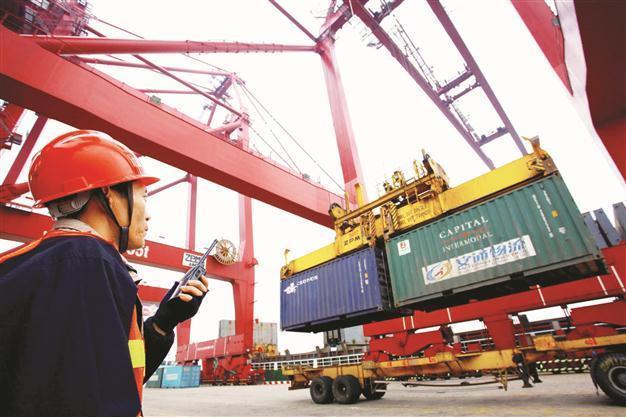China tames growth in the final quarter of 2011
Joe McDonald BEIJING - Associated Press

This Jan. 8 photo shows a worker operating hoists to unload containers at the Kaikou port in south China. The Chinese economy continues to grow at an impressive pace. AFP photo
China appears on track to avoid an abrupt economic slowdown with possible global repercussions after growth eased to a still robust 8.9 percent in the last quarter of 2011.The expansion in the world’s second-largest economy was the slowest in 2 1/2 years but December retail sales and factory output accelerated, data showed yesterday. Growth in the previous quarter was 9.1 percent.
“[The] outcome seems to confirm a ‘soft landing’ scenario,” said Frances Cheung of Credit Agricole CIB in Hong Kong.
China is one of the biggest importers and slower growth could have global repercussions if it cuts demand for iron ore, industrial components and other goods from Australia, Brazil, Southeast Asia and elsewhere.
Growth decelerated in 2011 as Beijing hiked interest rates and tightened investment curbs to prevent overheating and tame politically dangerous inflation. Policy makers reversed course and started easing lending late in the year after plunging U.S. and European export demand raised the threat of job losses and unrest.
The slowdown was in line with government plans, said Ma Jiantang, commissioner of the National Bureau of Statistics. He said the “ideal situation” would be to keep growth between 8.5 percent and 9 percent, with inflation low.
In 2012, China faces “complexity and challenges” due to global malaise and pressure for prices to rise, Ma said at a news conference. Still, he said, “The fundamentals of China’s long-term steady economic growth have not changed.”
Growth in the three months ending in December was the slowest since the second quarter of 2009, when the economy expanded 7.9 percent.
Retail sales growth rebounded to 18.1 percent from November’s 17.1 percent while factory output rose 12.8 percent, up from November’s 12.4 percent.
Soft landing scenario
“This all reaffirms our outlook on China for a soft landing,” said Moody’s Analytics economist Glenn Levine in a report. “Export demand has cooled, but domestic demand is still running strong.”
Consumer inflation, a volatile element in a society where poor families spend up to half their incomes on food, edged down in December to 4.1 percent after hitting a 37-month high of 6.5 percent in July.
That could give Beijing leeway to stimulate the economy, helping small companies that have been hurt by plunging export demand and squeezed by lending curbs, forcing thousands out of business and wiping out jobs.
Analysts expect Beijing to try to stimulate growth with an interest rate cut, tax cuts or other measures. The central bank promised pro-growth measures this month to help entrepreneurs, though it also pointed to inflation pressures and global uncertainties and said its monetary policy will stay “prudent.”
Industry surveys show manufacturing and exports contracted in November and December, while a slowdown in real estate sales triggered by government efforts to stop speculation and cool surging housing prices has sparked concern about the impact on the overall economy.
December import growth fell to 11.8 percent, barely half the previous month’s 22.1 percent gain.
“The slowdown has yet to come to an end,” said economist Zhang Xinfa at China Galaxy Securities in Beijing.
Analysts say Beijing still needs to boost consumer spending to reduce reliance on exports and investment to drive growth.
The government has pledged for years to reorient its economy but is only starting to make progress after its stimulus in response to the 2008 global crisis fueled a surge in construction spending.
Ma, the statistics official, pointed to the shift in population toward cities and said that might help to spur consumption growth.
“If we can rely more on domestic consumption,” said Credit Agricole CIB’s Cheung, “that will help the economy to sail through all these headwinds.”
















